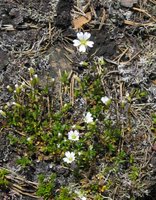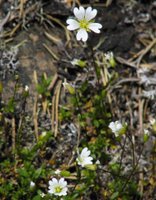Monday, July 24, 2006
Kaljutunturihärkki Kotkakurussa - Alpine mouse-ear in Eagle´s gorge
 Kuvatessamme jo heinäkuun alussa Jorma Laurilan kanssa Kynsivaaran kotkanpesää (katso Luontopäiväkirjan merkintä 1.7.2006), kalliopahdalla juuri pesän yläpuolella kasvoi ryväs valkoisia kukkia, jotka jäivät silloin meille tuntemattomiksi. Tarkempi, ottamani digikuvien tarkastelu paljasti kasvin tunturihärkiksi (Cerastium alpinum), ja lopulta sen alalajiksi kaljutunturihärkki (ssp. glabratum)
Kuvatessamme jo heinäkuun alussa Jorma Laurilan kanssa Kynsivaaran kotkanpesää (katso Luontopäiväkirjan merkintä 1.7.2006), kalliopahdalla juuri pesän yläpuolella kasvoi ryväs valkoisia kukkia, jotka jäivät silloin meille tuntemattomiksi. Tarkempi, ottamani digikuvien tarkastelu paljasti kasvin tunturihärkiksi (Cerastium alpinum), ja lopulta sen alalajiksi kaljutunturihärkki (ssp. glabratum)Härkeille on tyypillistä, että valkoisen kukan terälehti on syvään lovipäinen. Tunturihärkit ovat levinneisyydeltään pohjoisia tai fennoskandisia lajeja. Alalaji kaljutunturihärkki on melko yleinen pohjoisimpien tunturien kalkki- tai serpentiinisoraikoilla, kallioilla tai pahdoilla. Värriön luonnonpuisto on kaljutunturihärkin levinneisyyden ulkopuolella, tai juuri sen etelärajalla.
 Hieman yleisemmästä karvatunturihärkistä kaljutunturihärkin erottaa siitä, että nimensä mukaisesti varsi on kalju. Varren ylimmät nivelvälit ovat pitkät ja usein violetit, kuten alemmassa kuvassa.
Hieman yleisemmästä karvatunturihärkistä kaljutunturihärkin erottaa siitä, että nimensä mukaisesti varsi on kalju. Varren ylimmät nivelvälit ovat pitkät ja usein violetit, kuten alemmassa kuvassa.While searching for Golden eagle's nest at Kynsivaara hill with Jorma Laurila, already in the beginning of July (see Nature Diary post of 1 July) we noticed a cluster of small white flowers on the cliff above the nest. The flower remained unidentified for us.
Later study, based on digital photos (we avoid taking samles of plants in the nature reserve, even for research purposes) revealed the species. It belongs to mouse-ears (Cerastium sp.), and by species it is Alpine mouse-ear (C. alpinum). It is by distribution a typical Scandinavian species which grows on the arctic fells.
The specimen in the photo belongs further to subspecies glabratum, which is is known to grow on the northernmost fells on gravel and cliff sites, often on calcareous or serpentine stone dominated soils. The distribution range of the subspecies glabratum is north of Varrio Nature Reserve, or the flowers growing on Kynsivaara hill are just on the southern edge of range of this arctic species.